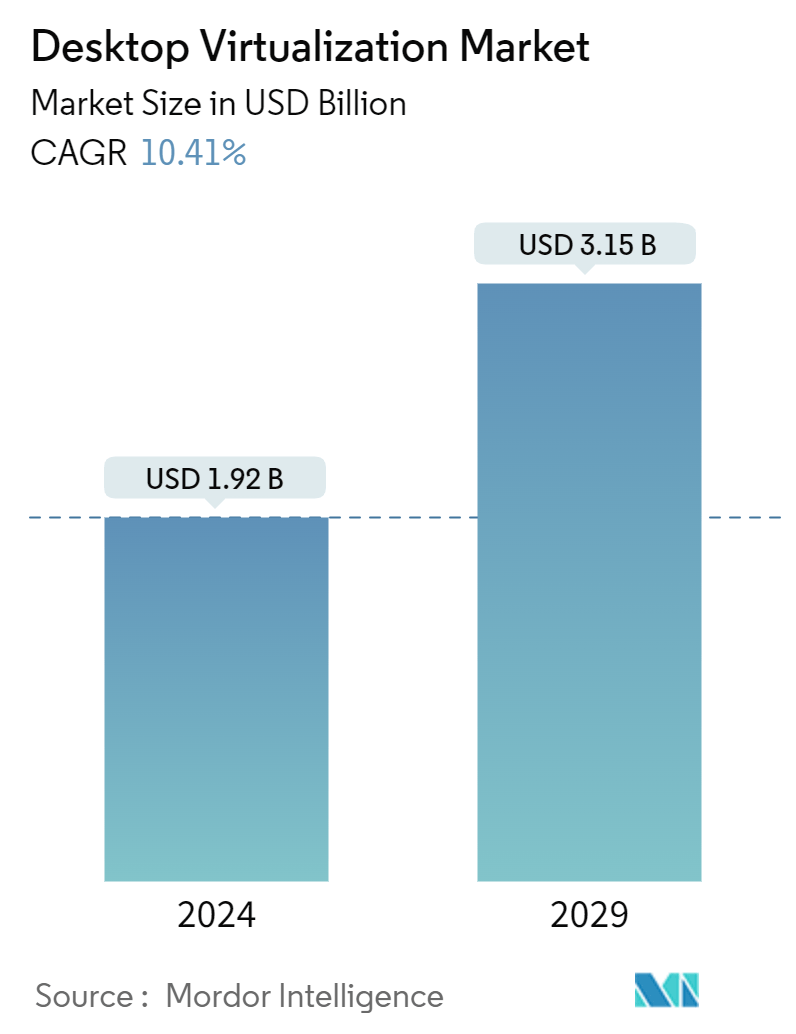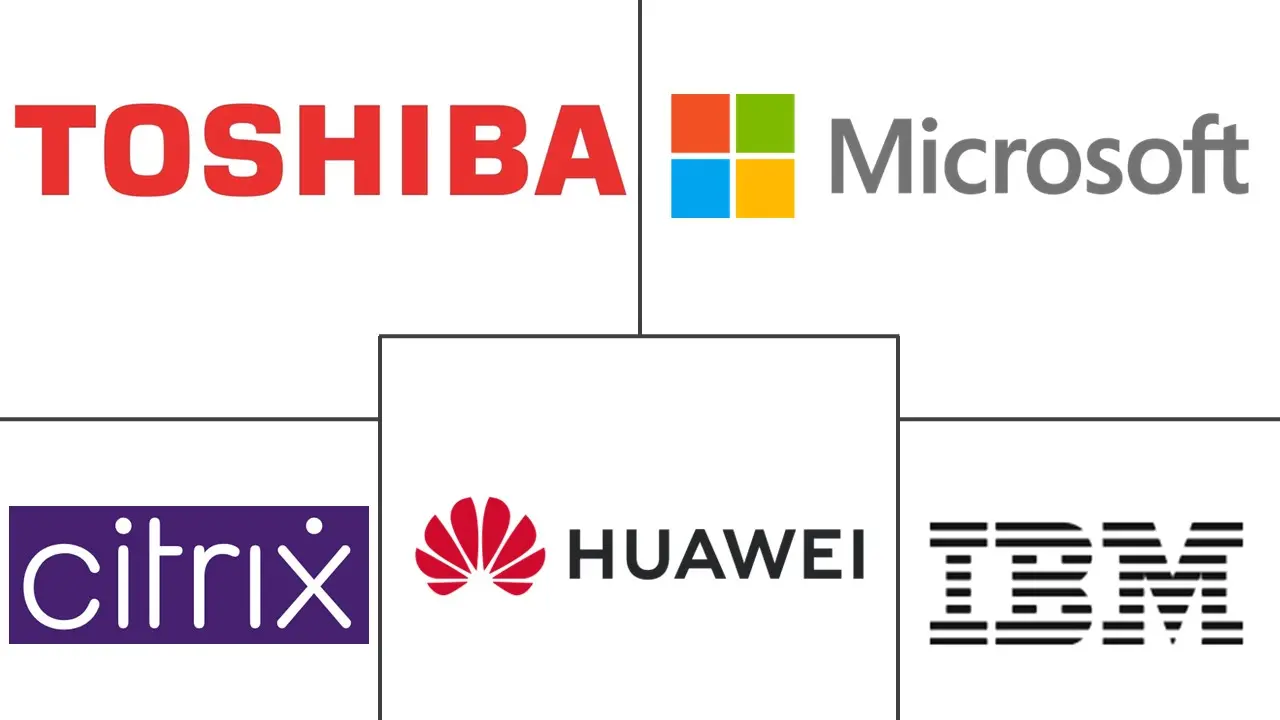Market Size of Retail Desktop Virtualization Industry

| Study Period | 2019 - 2029 |
| Market Size (2024) | USD 1.92 Billion |
| Market Size (2029) | USD 3.15 Billion |
| CAGR (2024 - 2029) | 10.41 % |
| Fastest Growing Market | Asia Pacific |
| Largest Market | North America |
| Market Concentration | Low |
Major Players
*Disclaimer: Major Players sorted in no particular order |
Retail Desktop Virtualization Market Analysis
The Desktop Virtualization Market size is estimated at USD 1.92 billion in 2024, and is expected to reach USD 3.15 billion by 2029, growing at a CAGR of 10.41% during the forecast period (2024-2029).
The desktop virtualization market has gained significant traction, driven by the rapid adoption of cloud computing and increasing automation across various sectors. Desktop virtualization, which involves running a desktop operating system within a virtual machine (VM) hosted on a centralized server, has become a crucial solution for businesses aiming to enhance flexibility, security, and cost efficiency. This technology, often delivered through platforms like Virtual Desktop Infrastructure (VDI) or Desktop as a Service (DaaS), enables remote desktop solutions and application virtualization, fostering a seamless virtual workspace.
Industry analysis reveals that desktop virtualization is becoming increasingly integral to modern IT infrastructures, especially with the rise of multi-cloud environments and the growing demand for end-user computing (EUC) solutions. Virtual machines (VMs) and software-defined data centers (SDDCs) are also playing a pivotal role in this landscape, enabling organizations to deploy virtual desktops efficiently. With companies like Citrix Systems Inc., VMware Inc., and Microsoft Corporation leading the market, the competition is intense, with significant innovation occurring in hyper-converged infrastructure (HCI) and thin clients.
As businesses continue to prioritize flexibility and remote work capabilities, the demand for virtual desktop deployment is expected to grow. The market outlook suggests a steady rise in the adoption of cloud desktops, particularly in industries where data security and accessibility are paramount. This shift is reflected in the market's segmentation, with a noticeable trend towards cloud deployment modes over on-premise solutions, particularly in regions like North America and Europe.
Cloud Computing's Role in Driving Desktop Virtualization
- Transformation of IT Infrastructure: Cloud computing has transformed traditional IT infrastructures, making desktop virtualization a feasible solution for businesses of all sizes. By leveraging cloud-based services, companies can deploy virtual desktops more efficiently, reducing the need for extensive physical infrastructure. This shift has been instrumental in enabling the scalability of virtual desktop infrastructure (VDI) and Desktop as a Service (DaaS) solutions. The flexibility offered by cloud desktops allows organizations to manage resources dynamically, which is particularly advantageous in multi-cloud environments where workload distribution and disaster recovery are critical.
- Enhanced Accessibility and Cost Efficiency: Cloud computing facilitates greater accessibility and cost efficiency, enabling organizations to support remote desktop solutions and application virtualization without significant upfront investment. With the proliferation of virtual machines (VMs), businesses can provide employees with secure and consistent access to virtual workspaces, regardless of location. This capability is essential in today’s work-from-anywhere culture, where mobility and data security are top priorities. Moreover, cloud desktops allow for more straightforward management and updates, which reduces the total cost of ownership (TCO) compared to traditional desktop setups.
Automation in Retail Boosting Virtualization Demand
- Streamlining Retail Operations: The growth in automation within the retail sector is significantly contributing to the demand for desktop virtualization. Retailers are increasingly adopting automation technologies to streamline operations, enhance customer experience, and improve supply chain efficiency. Desktop virtualization supports these efforts by providing a centralized platform for managing applications, inventory systems, and customer data across multiple locations. By implementing remote desktop solutions, retailers can ensure that their operations are synchronized, with real-time data access and processing capabilities that are critical in a fast-paced environment.
- Supporting Omnichannel Strategies: As retailers continue to develop omnichannel strategies, the need for seamless integration across physical and digital platforms becomes more pronounced. Desktop virtualization enables retailers to create a unified workspace that supports various functions, from point-of-sale (POS) systems to customer relationship management (CRM) tools. This integration is vital for delivering a consistent customer experience across channels. Additionally, with the rise of virtual desktop deployment, retailers can maintain robust security protocols and data protection measures, which are essential in handling sensitive customer information.
Retail Desktop Virtualization Industry Segmentation
Desktop virtualization separates the physical client device from its operating system. Instead of being stored locally, desktop data resides on a centralized or remote server. This setup enables users to access their data anytime and from anywhere. Retail companies stand to gain significantly from Virtual Desktop Infrastructure (VDI). With VDI, retailers can conveniently manage their vast enterprise networks, comprising thousands of devices, directly from their browsers.
The desktop virtualization market in retail is segmented by desktop delivery platform (hosted virtual desktop (HVD) and hosted shared desktop (HSD)), by deployment mode (on-premises and cloud), and by geography (North America, Europe, Asia Pacific, Latin America, Middle East and Africa). The report offers market forecasts and size in value (USD) for all the above segments.
| By Desktop delivery platform | |
| Hosted Virtual Desktop (HVD) | |
| Hosted Shared Desktop (HSD) |
| By Deployment Mode | |
| On-premise | |
| Cloud |
| By Geography*** | |
| North America | |
| Europe | |
| Asia | |
| Australia and New Zealand | |
| Latin America | |
| Middle East and Africa |
Retail Desktop Virtualization Market Size Summary
The Desktop Virtualization Market is poised for significant growth, driven by its integral role in digital workspaces and the increasing demand for remote access to enterprise data and applications. This technology has become a cornerstone for retailers, particularly large chains and hypermarkets, as they enhance store operations and boost online sales through investments in e-commerce and customer engagement. The market's expansion is further supported by the shift towards contactless retail transactions and the adoption of Data as a Service (DaaS) models, which offer flexibility and improved communication for remote employees. Despite challenges such as performance issues and high implementation costs, the market has benefited from the COVID-19 pandemic, which accelerated digital penetration and the need for remote operational tools.
North America leads the adoption of desktop virtualization solutions, fueled by advancements in social media, mobile technology, and cloud computing across various sectors, including retail. The region's strong presence of virtualization software vendors like VMware Inc. and Citrix Systems has contributed to market growth. As retailers embrace cloud-first strategies, solutions like Windows Virtual Desktop (WVD) offer enhanced security and management, streamlining desktop resources. The market is characterized by fragmentation, with key players such as Citrix Systems Inc., Toshiba Corporation, and Microsoft Corporation driving technological advancements and strategic partnerships. Recent developments include Citrix's expansion of cloud and on-premises solutions and VMware's collaboration with IBM to modernize mission-critical workloads, highlighting the ongoing innovation and competitive dynamics within the market.
Retail Desktop Virtualization Market Size - Table of Contents
-
1. MARKET INSIGHTS
-
1.1 Market Overview ( Includes the Impact due to COVID-19)
-
1.2 Industry Attractiveness - Porter's Five Forces Analysis
-
1.2.1 Bargaining Power of Buyers/Consumers
-
1.2.2 Bargaining Power of Suppliers
-
1.2.3 Threat of New Entrants
-
1.2.4 Threat of Substitute Products
-
1.2.5 Intensity of Competitive Rivalry
-
-
-
2. MARKET SEGMENTATION
-
2.1 By Desktop delivery platform
-
2.1.1 Hosted Virtual Desktop (HVD)
-
2.1.2 Hosted Shared Desktop (HSD)
-
-
2.2 By Deployment Mode
-
2.2.1 On-premise
-
2.2.2 Cloud
-
-
2.3 By Geography***
-
2.3.1 North America
-
2.3.2 Europe
-
2.3.3 Asia
-
2.3.4 Australia and New Zealand
-
2.3.5 Latin America
-
2.3.6 Middle East and Africa
-
-
Retail Desktop Virtualization Market Size FAQs
How big is the Retail Desktop Virtualization Market?
The Retail Desktop Virtualization Market size is expected to reach USD 1.92 billion in 2024 and grow at a CAGR of 10.41% to reach USD 3.15 billion by 2029.
What is the current Retail Desktop Virtualization Market size?
In 2024, the Retail Desktop Virtualization Market size is expected to reach USD 1.92 billion.

